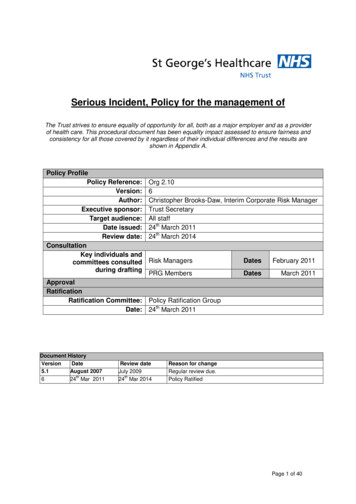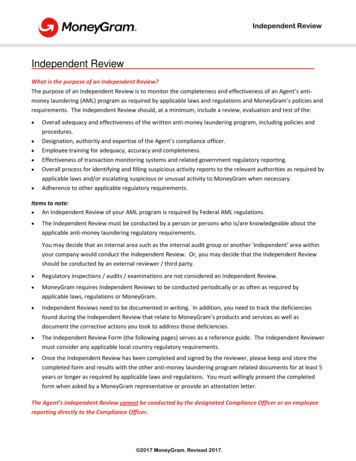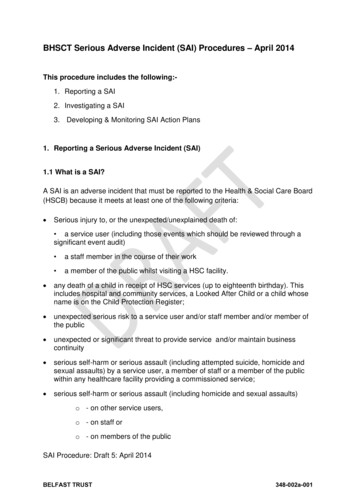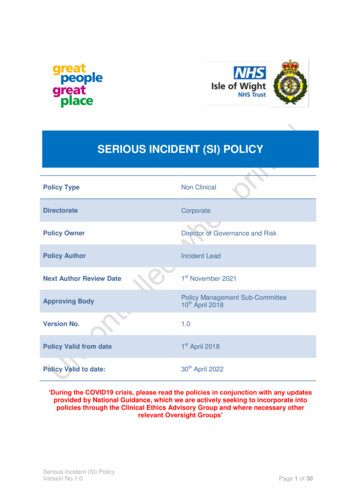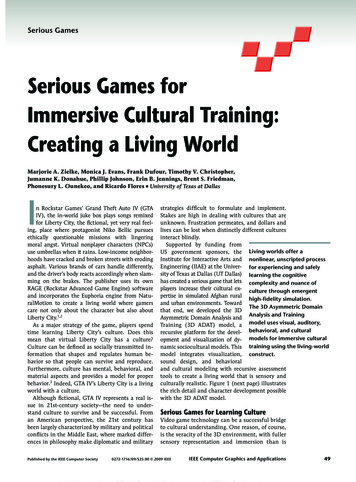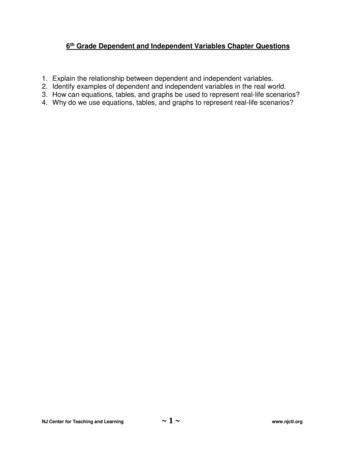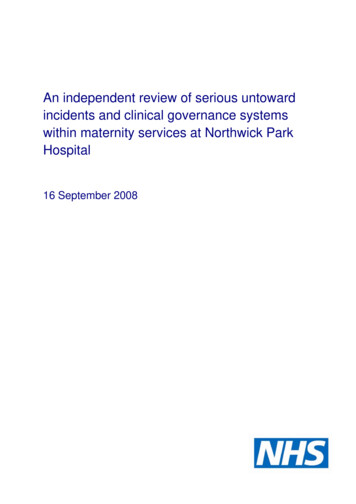
Transcription
An independent review of serious untowardincidents and clinical governance systemswithin maternity services at Northwick ParkHospital16 September 2008
ContentsAbout this report3Foreword4Executive summary51.Background72.Review panel, process and terms of reference83.Summary of five serious untoward incidents94.Overall conclusions from the review of five serious untowardincidents155.Review of governance arrangements176.Application of the risk management framework207.Professional supervision228.Participation in Trust governance and risk procedures239.Barriers to good practice2310.Areas of good practice2411.Key recommendations2512.Summary27AppendicesAppendix one: References28Appendix two: Terms of reference29Appendix three: Biographies of the panel32Appendix four: Summary of response from the HealthcareCommission33Appendix five: Draft action plan by The North West London HospitalsNHS Trust in response to recommendationsAn independent review of serious untoward incidents and clinical governance systemswithin maternity services at Northwick Park HospitalTuesday 16 September 2008342
About this reportThis report presents the findings and conclusions of an independent review intoclinical governance arrangements within maternity services at The North WestLondon Hospitals NHS Trust.The report has only been altered where it was necessary to remove information toprotect the confidentiality of patients and to ensure it makes sense to the reader.This report therefore does not provide the full specific clinical details of the threematernal deaths which took place during 2007/08 or the two serious untowardincidents (SUIs) that occurred at the Trust during this time. However it does include asummary of each case and overall conclusions of the review panel.This report includes a summary of the response to the report from the HealthcareCommission (appendix four). It also includes an action plan which has beendeveloped by the Trust in response to the recommendations made by the reviewpanel and the Healthcare Commission (appendix five).An independent review of serious untoward incidents and clinical governance systemswithin maternity services at Northwick Park HospitalTuesday 16 September 20083
ForewordAs the independent Chair of the panel, I am pleased to present this report whichdetails the findings of an independent expert panel into the safety of workingpractices within the maternity unit of The North West London Hospitals NHS Trust.In April 2008, following three maternal deaths and two other untoward incidents inthe past year within its maternity unit, The North West London Hospitals NHS TrustBoard instigated a review to undertake a full analysis of the cases. The terms ofreference also included a review of wider issues of risk management andgovernance arrangements in the unit to ensure they remained fit for purpose andprovided assurance for the public as to safe working practices and environment forwomen.Whilst undertaking our investigations both I and my colleagues on the panel wereever mindful of the tragic nature of the circumstances which prompted this reviewand we wish to express our sincere condolences to the families for the loss of theirloved one.I am grateful for the time and expertise of the whole panel and in particular to theexternal experts who reviewed and scrutinised the evidence and assisted inproviding the analysis and conclusions laid out in this report.It is my belief that the findings of this report provide an accurate reflection of both thegood practice established in the maternity unit since special measures were put inplace and subsequently lifted, whilst also recognising the need for continuousimprovement in providing the safest care possible for women and babies.Ms Ann GrovesChair of the Review PanelAn independent review of serious untoward incidents and clinical governance systemswithin maternity services at Northwick Park HospitalTuesday 16 September 20084
Executive summaryIn April 2008, following three maternal deaths in one year and two other seriousuntoward incidents (SUIs) in its maternity unit, The North West London HospitalsNHS Trust (NWLH) initiated an independent review into the root cause of theincidents, the appropriateness of the maternity unit’s governance systems and theirapplication (including risk identification, risk management, incident reporting andreview, multidisciplinary working, leadership and professional supervision) barriers togood practice and areas of excellent practice.In consultation with NHS London and the Healthcare Commission (HCC) aninvestigating panel was convened. This was chaired by a non-executive boardmember of Harrow Primary Care Trust (PCT) and included an executive member ofBrent PCT, a Professor of Obstetrics (nominated by the Royal College ofObstetricians and Gynaecologists), a Professor of Midwifery and a Supervisor ofMidwives (recommended by the Local Supervising Authority). They were supportedby the Medical Director, Director of Nursing and Midwifery and Assistant Director ofIntegrated Governance of the Trust.Having agreed the terms of reference, the panel reviewed the following evidence: The Trust’s SUI policy The SUI reports and action plans Chronologies of a series of other serious incidents Maternity clinical governance records, including policies, organisation charts,attendance records, minutes and action plans.External experts also conducted interviews with staff groups including midwivesworking in the hospital and community settings, senior midwives, supervisors ofmidwives and consultant obstetricians, paediatricians and anaesthetists. Thefindings of the review were mapped against the HCC recommendations (July 2005;8, 45-51).The work of the panel was completed on 24 June 2008. The findings of the reviewwere: The maternal deaths and incidents were not the result of deficiencies of care. Standards of care when a woman is admitted to the delivery suite are well aboveaverage. Incident reporting and investigation systems are of a high quality. There are examples of excellent practice which should be widely disseminated. Governance systems are fit for purpose and generally well applied.An independent review of serious untoward incidents and clinical governance systemswithin maternity services at Northwick Park HospitalTuesday 16 September 20085
Areas for further improvement in governance systems and maternity care wereidentified. The latter may have influenced the timeliness of treatment in some of thecases. To produce further reductions in risk for the large proportion of vulnerable andhigh risk women attending the unit some essential recommendations are made.These include: Better delivery of antenatal care in the community by an expanded team ofcommunity midwives, ensuring that all women have equitable standards ofantenatal care including appropriate access to obstetric and midwifery services,particularly those most vulnerable. Optimising antenatal care of high risk women by applying best practice guidelines(including monitoring the effectiveness of the ‘did not attend’ policy) andimplementing recommendations of the National Institute for Health and ClinicalExcellence (NICE) guidelines 2006 for the care of women in the postnatal period,strengthening leadership skills and inter-professional and inter-specialtycommunication. Providing better opportunities for multidisciplinary learning from incidents. Reviewing assurance processes in the governance framework.The panel has provided a list of essential requirements which should be incorporatedinto any action plan generated by the Trust in response to this review.An independent review of serious untoward incidents and clinical governance systemswithin maternity services at Northwick Park HospitalTuesday 16 September 20086
1.BackgroundA previous investigation by the Trust, following a series of maternal deaths betweenApril 2002 and April 2005, was followed by a detailed enquiry by the HealthcareCommission (Healthcare Commission; Review of Maternity Services provided byThe North West London Hospitals NHS Trust, July 2005).This enquiry resulted in the development of an action plan which led to majorimprovements in staffing levels, physical environment and governance arrangementswithin maternity services at Northwick Park Hospital.The Healthcare Commission’s final report in August 2006 (Healthcare Commission;Investigation into 10 maternal deaths at, or following delivery at, Northwick ParkHospital, The North West London Hospitals NHS Trust, between April 2002 and April2005, p107) acknowledged the progress made by the Trust in providing a better andsafer service for women, detailing 13 specific areas where improvements had beenachieved.The action plan was fully implemented under the supervision of the HealthcareCommission and the then North West London Strategic Health Authority. Allstakeholders had confidence in the outcome and external surveillance (specialmeasures) was removed in September 2006.During the investigation and the implementation of the action plan, no furthermaternal deaths occurred in the unit. When three further deaths occurred during2007/08, the Trust Board recognised its responsibility to re-examine the governanceand practice of maternity care in order to reassure the public and the families of thewomen involved that they could have confidence in the safety of the service.It was also recognised that this concerned other parties, including the HealthcareCommission, NHS London and Brent and Harrow PCTs and the Local SupervisoryAuthority (LSA). In consultation with these partners it was agreed that the enquirywas necessary and that it should be independent of the Trust. It was agreed thatexternal professional experts should be invited to review the evidence and advise thepanel on the current fitness for purpose of the governance arrangements of thematernity unit. The panel would also advise whether improvements in practice andgovernance should be made and endorse any elements of good practice which werediscovered.An independent review of serious untoward incidents and clinical governance systemswithin maternity services at Northwick Park HospitalTuesday 16 September 20087
2.Review panel, process and terms of referenceThe investigation was conducted by an independent panel chaired by a NonExecutive member of Harrow PCT (Ms Ann Groves).It included: Professor of Midwifery (Professor Jacqueline Dunkley-Bent)Supervisor of Midwives (Ms Cathy Rogers) nominated by NHS LondonProfessor of Obstetrics (Professor James Drife) nominated by the RoyalCollege of Obstetricians and GynaecologistsExecutive Member of Brent PCT (Ms Thirza Sawtell).They were supported by the Trust’s Medical Director (Mr Michael Burke) Director ofNursing and Midwifery (Ms Elizabeth Robb) and Assistant Director for IntegratedGovernance (Ms Catherine Thorne). Biographies of panel members are included inappendix one.2.1 Process of the investigationThe process of the investigation included:1. Examination of the complete records of five cases (three cases of maternaldeath and two others).2. Examination of serious untoward incidents (SUI) reports on seven recentcases of major obstetric haemorrhage (MOH).3. Examination of clinical risk management group minutes during 2007,maternity governance board minutes, reports for patient safety committeefrom maternity, reports to clinical governance committee from maternity, fiveSUI reports and action plans, the maternity escalation policy, organisationalchart and staff establishment figures.4. Review of the Local Supervision Strategy.5. Examination of relevant clinical guidelines.6. Visits to Northwick Park Hospital on 24 June (Professor Drife) and on 20June (Professor Dunkley-Bent and Ms Rogers) when departmental visits weremade and semi-structured interviews conducted with representative groups ofmidwives, obstetricians, paediatricians, anaesthetists and maternitymanagers.2.2 Terms of referenceThe agreed terms of reference of the review panel are included in appendix two.An independent review of serious untoward incidents and clinical governance systemswithin maternity services at Northwick Park HospitalTuesday 16 September 20088
3.Summary of five serious untoward incidentsThe complete notes of the three women who died during 2007/08 and of two nonfatal serious untoward incidents in the maternity unit were examined by the reviewpanel.The case histories are described in detail in the Trust’s serious untoward incidentreports and in the full report produced by the review panel. Abbreviated summariesof all five cases are given below and include conclusions of the review panel in eachcase. For the purposes of this document and in order to protect the confidentiality ofpatients they are published as woman A, B, C, D and E.3.1 Three maternal deaths3.1.1 An abbreviated case summary of woman AWoman A was a 25 year old mother of two with a Body Mass Index (BMI) of 40 anda previous history of poor attendance at antenatal clinics.She booked for antenatal care at 10 weeks and was referred to a consultantobstetrician because of her high-risk status (due to her BMI). She did not attend theconsultant clinic.At 34 weeks of pregnancy she experienced abdominal pain and was admitted toNorthwick Park Hospital. She was seen by a consultant and discharged home withan appointment to attend the hospital’s clinic in two weeks’ time. She did not attendthis or other antenatal appointments.At 40 weeks (expected date of delivery) of her pregnancy, woman A was admittedinto hospital with suspected onset of labour but this was not the case and she wassent home. Four days past her expected date of delivery she was admitted intohospital in labour and gave birth shortly afterwards.After the birth, swabs were taken which showed the presence of beta haemolyticstreptococci (a type of infection). The baby was treated with antibiotics and threedays after delivery she was discharged home. A referral was made to the healthvisitor in view of the patient’s vulnerable status.On day 21 after delivery of her baby, an ambulance was called because ofhyperventilation problems over the previous few days. Woman A had a cardiacarrest and died in the ambulance. Post mortem examination showed that she diedfrom pulmonary embolism.Conclusion of review panelWoman A was appropriately managed and current standards of care were correctlyapplied. Nevertheless her case highlights ways in which care could be improved –both locally, with more attention paid to non-attendees for antenatal care, andAn independent review of serious untoward incidents and clinical governance systemswithin maternity services at Northwick Park HospitalTuesday 16 September 20089
nationally, with improved guidelines on thromboprophylaxis (blood thinning drugs toprevent blood clots)*.The deficiencies in antenatal care were identified in the Trust’s action plan(09.03.2008) and are being addressed by the recruitment of 20 community midwivesand the transfer of antenatal care to the community midwifery service managed bythe Trust.The panel recommends that the organisation of this expanded team should takeaccount of the special needs of the community, for example by establishing a teamfor vulnerable women. NICE (2006) recommended that all women should be giveninformation on warning signs and symptoms of postnatal morbidity and this practiceshould be adopted by the maternity unit.*Current Royal College of Obstetricians and Gynaecologists (RCOG) guidelines onthromboprophylaxis do not differentiate between obesity and morbid obesity.3.1.2 An abbreviated case summary – woman BWoman B was a 39 year old expecting her first baby with a two year history ofinfertility. She booked at 11 weeks of pregnancy and had an amniocentesisperformed at 17 weeks.She was seen routinely by the midwives and at 34 weeks she was admitted tohospital with antepartum haemorrhage (vaginal bleeding). This settled quickly and ascan showed no placental abnormality. She was discharged and attended thehospital antenatal clinic a week later.At 36 weeks she was again admitted to hospital with a small antepartumhaemorrhage. An examination was carried out which showed that the bleeding wasnot caused by problems with the placenta.Two weeks later she was seen by a GP at term and no abnormalities were noted.She was asked to return in a week.Six days later she phoned the delivery suite at 12.53 and was admitted to thedelivery suite at approximately 14.00 with constant abdominal pain and having notfelt the baby move since the previous night. Twenty minutes later woman B had aseizure. Emergency procedures were correctly followed. A consultant obstetricianwas present immediately along with other obstetric and midwifery staff. Magnesiumsulphate was given and a consultant anaesthetist was called and attended promptly.An emergency caesarean section was carried out and a baby girl was delivered at15.01.Woman B suffered massive haemorrhage. Despite the resuscitation team’s attemptsto resuscitate she died. After post mortem examination the cause of death was givenas amniotic fluid embolism (AFE).An independent review of serious untoward incidents and clinical governance systemswithin maternity services at Northwick Park HospitalTuesday 16 September 200810
Conclusions of panelAmniotic fluid embolism (AFE) is a rare complication that cannot be predicted orprevented and it is hard to see how the fatal outcome in woman B’s case could havebeen avoided. Nevertheless two episodes of mild bleeding in the last weeks ofpregnancy should have reclassified her as a high-risk case.AFE was the cause of 17 maternal deaths in the UK in 2003-2005 [1]. There is nospecific treatment for AFE other than general resuscitatory measures and thecondition has a high mortality rate. It cannot be predicted and over the years thesearch for specific risk factors has been frustratingly inconclusive.When woman B had a seizure she was immediately attended to by a consultantobstetrician and promptly delivered by emergency caesarean section. This wasappropriate management. It was reasonable to assume initially that the cause of theseizure was eclampsia, as AFE usually presents with collapse and torrentialbleeding.Administration of magnesium sulphate did not make any difference to the outcome.AFE tends to occur during labour and in woman B’s case it could have occurredwhenever she went into labour. Her collapse could not have been predicted andcould not have been treated more promptly. There is no clear lesson that can bedrawn about how her death could have been prevented.3.1.3 An abbreviated case summary – woman CWoman C was a 28 year old who had arrived in the UK from Afghanistan at the verybeginning of her pregnancy. Her first language was not English and an interpreterwas required.Her care started at another London hospital at 7 weeks pregnancy because ofvaginal bleeding and again at 17 weeks pregnancy with urinary tract symptoms. Shewas discharged and advised to ask her GP to refer her for antenatal care. As womanC told the hospital that she had not been resident in the UK for long, staff advisedher to contact social services and they referred her to the community midwives.Woman C was then seen by a midwife at Northwick Park Hospital at 28, 30 and 32weeks’ pregnancy. No abnormalities were noted. At 39 weeks the midwife foundthat patient C’s blood pressure was higher than at booking (26 weeks) and she hadfacial oedema (swelling) which can be an indication of pre-eclampsia.The next day (one day before expected date of delivery) her blood pressure washigher and she had proteinuria (protein in urine). A decision was made to inducelabour when the delivery suite was able to accommodate her. She was transferredthe next day and induction started the following day.Woman C had a natural delivery of baby girl at 02.25 the next morning. Immediatelyafter delivery vaginal bleeding was noted from the vaginal wall and the registrar wasasked to review her. Vaginal tears were sutured in theatre by the consultant. It wasAn independent review of serious untoward incidents and clinical governance systemswithin maternity services at Northwick Park HospitalTuesday 16 September 200811
noted that there was difficulty in accessing all the tears, and a vaginal pack wasinserted. Woman C had sudden severe diarrhoea around this time. The vaginal packwas removed later that day and woman C was transferred to the high dependencyunit (HDU) on the delivery suite. She was regularly reviewed.Early in the morning of day four, woman C collapsed and a diagnosis of toxic shockwas made. Resuscitation was started and woman C was transferred to the IntensiveCare Unit (ITU).The cause of her collapse was found to be necrotizing fasciitis with an extendedspectrum beta-lactamase E-Coli (this is a bacterium highly resistant to antibiotics). Atautopsy the sutured vaginal tear was noted to be delicate. There was destruction ofthe tissues between the vagina and the rectum which could have been due to theinfection or possibly birth trauma.Conclusions of the panelThe external panel concluded that woman C’s care was of a good standard once theclient was referred to Northwick Park and that the overall quality of care bycommunity midwives in the antenatal period was high.However, woman C’s difficulties with antenatal care before 28 weeks’ pregnancy arevery concerning. There seems to have been a lack of understanding of, or responseto, the needs of asylum seekers who are known to be a high-risk group. However,this was not the fault of Northwick Park Hospital.The panel also noted that interpreters were used appropriately throughout and thatmidwifery plans of care were generally of a commendable standard. During labourher care was made difficult by the need for interpreters but these were provided.The cause of her vaginal tears is unclear. They were repaired in the standard way bya consultant. The reason for her infection is also unclear but may be related todiarrhoea around the time of delivery. There were no clear signs of sepsis ortoxaemia until day four, when she suffered rapid collapse, as can occur withoverwhelming infection. The panel cannot identify any clear deficiencies in her carein hospital.3.2 Non-fatal cases3.2.1 An abbreviated case summary – woman DWoman D was a 36 year old Black African (Somali) with three children and hadbooked late for antenatal care in this pregnancy because she had been out of theUK.At 23 weeks’ pregnancy she was referred urgently to Northwick Park Hospital by herGP. She was seen and booked at 26 weeks of pregnancy. It was noted that she hadAn independent review of serious untoward incidents and clinical governance systemswithin maternity services at Northwick Park HospitalTuesday 16 September 200812
a history of intrauterine growth retardation (a condition where a baby’s growth slowsor ceases) and she was therefore referred to a consultant clinic.At 29 weeks’ pregnancy, woman D was admitted to the delivery suite feeling unwell(cough and high temperature). She was started on antibiotics and the next day wasseen by a consultant obstetrician, referred to the chest physicians and the InfectiousDiseases Team with suspected tuberculosis (TB).She remained in hospital for five days. The diagnosis of TB remained uncertain. Shewas then discharged home.After three days, woman D was admitted to the delivery suite. Abnormal liverfunction tests were noted. She was admitted to the antenatal ward and transferred tothe Infectious Diseases Unit the next day where she stayed for 10 days, when shewas discharged on anti-tuberculosis treatment.The following day woman D was admitted via A&E with vomiting and diarrhoea. Shewas assessed and restarted on anti-TB treatment and was later discharged home.At 36 weeks of pregnancy woman D was admitted in labour. She was jaundiced andunwell. It was noted that there was a need to rule out fatty liver of pregnancy (a rarebut serious complication of pregnancy). The consultant was informed. Woman Dwent on to have a normal delivery of a girl.At 05.45 on the day of delivery she was reviewed by the physicians and thedifferential diagnosis included isoniazid (TB drug) induced fatty liver or possible fattyliver of pregnancy. Woman D was transferred to the liver unit at another LondonHospital. She had a liver transplant and has survived. Liver histology revealedinflammatory changes but a specific cause for her liver failure was not revealed.The SUI investigation received an expert opinion from a consultant in infectiousdiseases who did not feel that the TB drugs were solely to blame for her liver failure,and did not feel that there was any substandard management.Conclusions of the panelThis case demonstrates the need for a robust routine system of communicationbetween obstetrics and other specialties in the hospital. It should not be necessaryto have to try to invent such a system on a case-by-case basis when it is required.This has been recognised in the Trust’s action plan.The external panel recommended the need for integrated care pathways of womenrequiring multidisciplinary input which was recommended by the internal SUI panel.The panel also commended the team for systems and processes that were clearlyevident and support safety in practice such as the risk factor assessment sheetcompleted on booking with recommended care pathways, the quality of midwiferyadmission reviews and management plans.An independent review of serious untoward incidents and clinical governance systemswithin maternity services at Northwick Park HospitalTuesday 16 September 200813
3.2.2 An abbreviated case summary – woman EWoman E was booked at 16 weeks of pregnancy. She was under the care of aconsultant and was expecting twins.At 32 weeks of pregnancy woman E was admitted to the delivery suite because ofconcern that she was going into labour.Woman E’s pains settled and she was discharged home the next day after beingseen by a consultant. Within the next six days, woman E was admitted to thedelivery suite three times. On the last of these admissions she was transferred to apostnatal ward and was seen by the midwife and the obstetric senior house officer.Later that evening her membranes ruptured and woman E was admitted to thedelivery suite. It became clear that delivery would be very difficult. Woman E wasseen by a consultant obstetrician and caesarean section was recommended andagreed to. The caesarean section was carried out and two babies were delivered.Woman E was stabilised and transferred to the Intensive Care Unit.Conclusions of the panelThis was an extremely challenging and unusual case. Nevertheless more could havebeen done in terms of contingency planning and multidisciplinary discussion in earlypregnancy.The case highlights the need for a clear leadership role on the part of a consultantobstetrician who would initiate such discussion and be responsible for a detailed planof management. The external review panel of this case made a number of commentsabout the high standards of midwifery practice throughout this woman’s careincluding the comprehensive booking history taken and management plan made inview of risks identified, and the plan of care following this woman’s admission tohospital at 33 weeks.Notable aspects of midwifery practice identified by the panel were the: Attempts made to involve client in all aspects of decision makingNon-judgemental attitudeKindness and respectQuality of communicationLevel of support given.An independent review of serious untoward incidents and clinical governance systemswithin maternity services at Northwick Park HospitalTuesday 16 September 200814
4. Overall conclusions from the review of the fiveserious untoward incidentsThe five serious untoward incidents which the review examined have some factors incommon. They were all high risk cases; four of the women were non-Caucasian andin four cases communication was difficult for language, cultural or clinical reasons.The fact that they were all high risk cases highlights the need not only for meticulousrisk assessment as early as possible in each pregnancy and equity of access tomidwifery services but also for continuing this risk assessment in the postnatalperiod, and for increased consultant obstetrician input into antenatal care.There were no deficiencies in care in relation to the application of nationalguidelines. Care on the delivery suite was of a high standard, with better thanaverage consultant involvement and excellent plans of care by midwives followingantenatal admission. Processes for logging calls to the labour ward were good andsupervisors of midwives were appropriately informed. Nevertheless, with theexception of one case, supervisors of midwives were not subsequently engaged withthe serious untoward incident (SUI) panel investigation. This was evident from theterms of reference of the SUI panel and minutes of meetings.None of the deaths or SUIs could have been prevented by better attention to currentguidelines or protocols. In the three fatal cases, however, there were opportunitiesfor better high-level clinical care in interpreting and reacting to apparently “minor”symptoms. Consultant obstetrician involvement in these cases was limited to thelabour ward and was much less before or after the intrapartum period (duringdelivery).The non-fatal SUIs revealed deficiencies in communication and co-ordinationbetween obstetrics and other specialties in the hospital. The cases focus attention onthe antenatal care of high-risk women. When high risk is recognised, there needs tobe clear leadership from a named consultant obstetrician. This role requires handson involvement and can be time consuming, and it is important that this developmentdoes not put at risk the high standards of consultant involvement in the labour ward.The cases reveal that the unit often runs at full capacity which can result in delays inwomen been seen and assess
the past year within its maternity unit, The North West London Hospitals NHS Trust Board instigated a review to undertake a full analysis of the cases. The terms of . Hospital, The North West London Hospitals NHS Trust, between April 2002 and April 2005, p107) acknowledged the progress made by the Trust in providing a better and .
